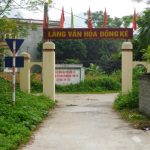In previous years, Dong Ke village, a village of the Muong people in Tran Phu Commune (Chuong My), offered very difficult living conditions. Since the expansion of Hanoi, Dong Ke has been entitled to the city’s policy on mountainous ethnic people and received the concern of the local Party committees and authorities. Since then, the village’s potential has been explored and its internal force has been strengthened to promote new vitality.

Dong Ke occupies nearly 5 km2 in an area having special terrain in Chuong My District. The village is located in an area abundant with rocky mountains along the city’s border with Hoa Binh Province. The village has 140 households, of which, Muong people account for 85%. Barren land, backward farming practices, poor infrastructure, and many more other factors were the causes that made the production and the life of people in this place very difficult. At one time, the poverty rate even reached 30%. Due to the geographic location and characteristics of population distribution, the Muong community encountered extremely difficulties. The barren agricultural land with small-scale farming models and backward farming practices and the depraved costly funeral customs of the Muong Dong people, a legacy from the past Lang Cun system, added to the increasingly difficulties of the villagers. During agricultural idle seasons, most of the people had to leave for other villages in hope for jobs. The school was located 10 km from the village, which meant children went to school without adequate protection and care. Many children had to drop out of school. There were only a handful of high school graduates. It was also very rare to find university or college graduates, or people with intermediate vocational diplomas. Due to the village’s distant location from the center parts of the commune and the district, its people did not have easy access to medical and educational services and encountered many difficulties in traveling. The village’s people had to travel several tens of kilometers just to get to the district’s health center to receive emergency services. Those were the reasons why poverty and backwardness surrounded the Muong people in Dong Ke all year round.
One could think that poverty and backwardness would never leave the Muong people who had already encountered hardships all their lives, but it is not the case now. The present-day Dong Ke has changed. The remote Muong village has been awakened. With the concern of Party committees and authorities at all levels and the support provided through the ethnic policies of the Party and the State, projects on waste, irrigation, and traffic have been implemented in Dong Ke. In addition to the support of the State, the local people also actively contributed their work days and capital to upgrade and improve the power system, roads, and schools in the village. Typical examples include Dong Ke village preschool, invested in with a capital of VND 2.8 billion in total, and the village’s cultural house, invested in with VND 1.3 billion, both completed in 2013 – 2014. To cater to the cultural and religious needs of the Muong people, the city has given a set of gongs (12 units) and 30 sets of Muong traditional costumes to the village. The village has set up a performance team consisting of 25 members to help preserve and promote the cultural identity of the Muong people.

For the Muong people in Dong Ke, the gongs are important ceremonial instrument. Gong ensembles are for ritual purposes and are considered an element of every ceremony. Each ceremony has at least one gong song. Mrs. Dinh Thi Phuc, leader of the Dong Ke performance team, said: “The sound of gong ensembles has been ingrained in the mind of the Muong people for a very long time. The sound of gongs in any Muong wedding is considered to be something so sacred that nothing can replace or compensate for it. The songs performed by Dong Ke musicians have reached the level of expressiveness appropriate to the state of mind and emotions of the people in each ceremony.”
Dong Ke village has been recognized twice as a cultural village. The gong sounds are heard all over the village, blended with the bustling air and excitement surrounding the people during every holiday or festival. The color of the Muong people’s traditional costumes brilliantly blooms, showcasing the vitality of change. The area of agricultural land of the village has been expanded by 53 hectares. The average harvested rice output is now 280 kg per Vietnamese acre. In addition to rice, the people also plant cassava and sweet potatoes on hilly land to bring in the additional income to their families.
Dong Ke of today not only ensures all of its households no longer have to worry about food shortages, but also has many good economic examples. The village now has 12 good livestock and farmyard models. The average income of the people has been increased, reaching approximately VND 15 million per year. Many households have made efforts to overcome difficulties and become better off, contributing to the development of the district. Some households in the village even provide electronic products, refrigerated products, motorbikes, and transportation services. A fine example is Mr. Tran Minh Cong’s household with a yearly revenue of hundreds of millions dongs, providing jobs and stable income to tens of workers.
The economy is growing sustainably, the education is focused on, and healthcare services have been provided to the people. Dong Ke’s social welfare really has the looks of that of a new rural era in the course of rural and agricultural industrialization and modernization.
Nguyen Hong Dieu

